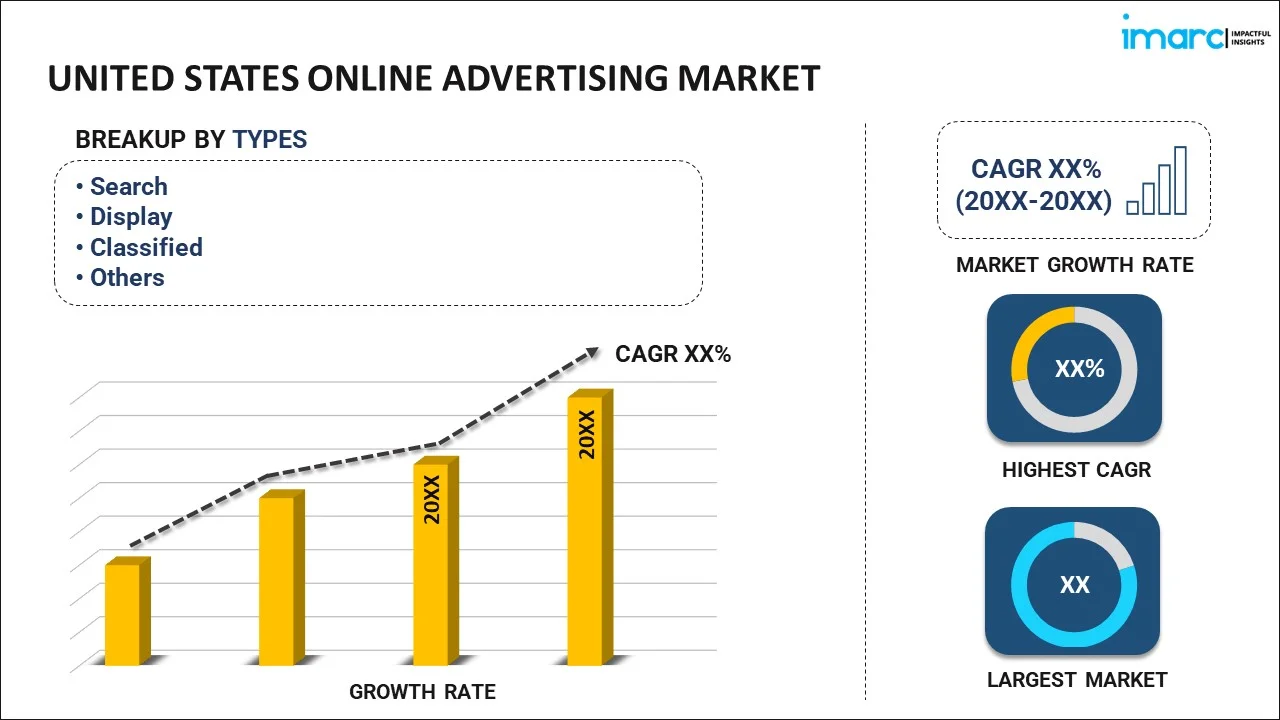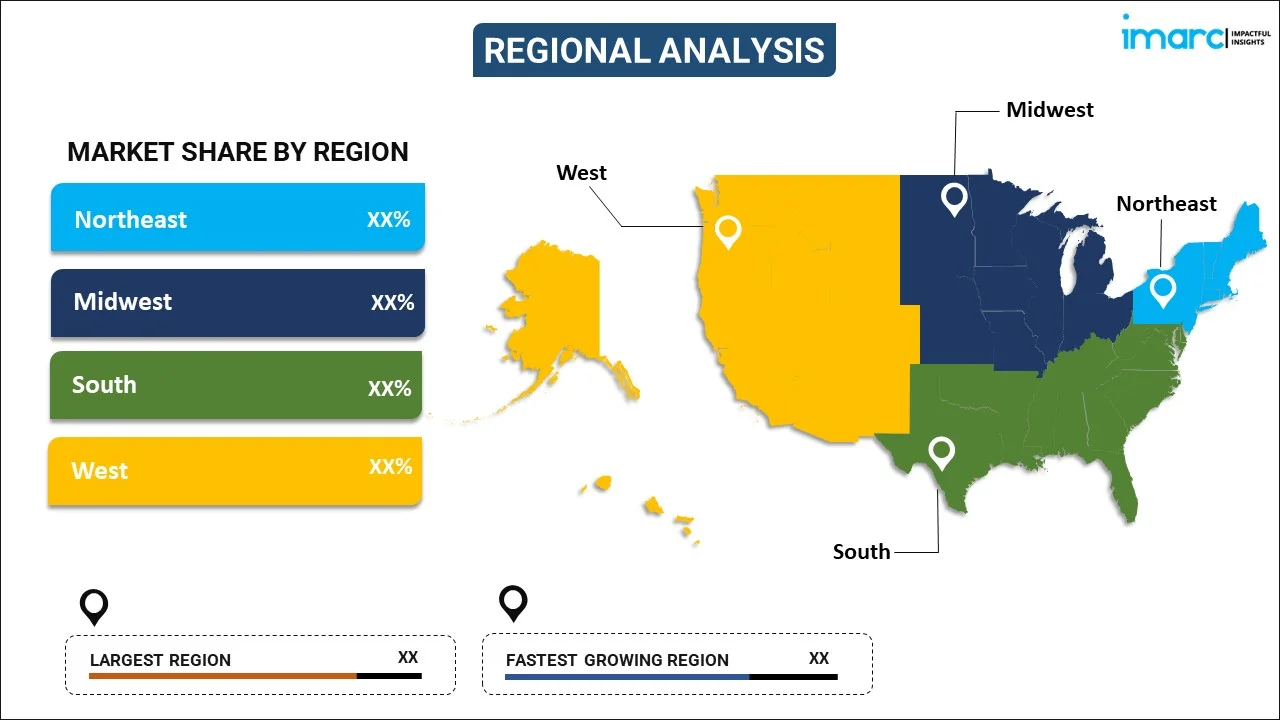
United States Online Advertising Market Report by Type (Search, Display, Classified, Video, and Others), Platform (Mobile, Desktop and Laptop, and Others), End User (Automotive, Retail and Consumer Goods, Healthcare, BFSI, Telecom, and Others), and Region 2025-2033
Market Overview:
The United States online advertising market size reached USD 61.9 Billion in 2024. Looking forward, IMARC Group expects the market to reach USD 126.2 Billion by 2033, exhibiting a growth rate (CAGR) of 8.1% during 2025-2033. The rapid technological advancements, shift in consumer behavior, rising influence of social media, rapid e-commerce growth, growing mobile-first approach, increasing prominence of content marketing, and growing competition among tech giants represent some of the key factors driving the market.
|
Report Attribute
|
Key Statistics
|
|---|---|
|
Base Year
|
2024
|
|
Forecast Years
|
2025-2033
|
|
Historical Years
|
2019-2024
|
|
Market Size in 2024
|
USD 61.9 Billion |
|
Market Forecast in 2033
|
USD 126.2 Billion |
| Market Growth Rate 2025-2033 | 8.1% |
Online advertising is a digital marketing strategy that utilizes the internet to promote products, services, or brands to a vast and diverse audience. It encompasses a wide range of methods and channels, all aimed at reaching potential customers online. These methods include display ads, search engine marketing (SEM), social media advertising, and email marketing. One of the primary advantages of online advertising is its ability to target specific audiences with precision. Advertisers can tailor their campaigns to reach individuals based on various factors, such as demographics, interests, online behavior, and location. This level of targeting makes online advertising cost-effective and also enhances its effectiveness in reaching the right individuals at the right time.
United States Online Advertising Market Trends:
The way consumers access information and make purchasing decisions has fundamentally changed. Nowadays, an increasing number of individuals rely on the internet to research products, read reviews, and make online purchases. This shift in consumer behavior has made online advertising an indispensable channel for businesses to reach their target audiences effectively. Additionally, the United States has a robust economy, which provides a favorable environment for advertising spending. In times of economic growth, businesses tend to allocate more resources to advertising and marketing efforts to capitalize on consumer spending. Conversely, during economic downturns, cost-effective online advertising becomes even more appealing. Other than this, the abundance of data available in the digital realm has transformed marketing strategies. Online advertising leverages data analytics to segment audiences, measure campaign performance, and refine targeting. This data-driven approach allows advertisers to optimize their ad spend, resulting in more efficient and effective campaigns. Besides this, the proliferation of social media platforms has had a profound impact on the online advertising landscape. Social media platforms like Facebook, Instagram, Twitter, and LinkedIn offer highly targeted advertising options, enabling businesses to reach users based on their interests, demographics, and behaviors. These platforms have become integral to digital marketing strategies. In line with this, the growth of e-commerce in the United States has created significant opportunities for online advertising. With the rise of online shopping platforms like Amazon, businesses invest heavily in advertising to compete for visibility and market share. Product listings, sponsored ads, and affiliate marketing have all contributed to this trend. Furthermore, the widespread adoption of smartphones has led to a mobile-first approach in online advertising. Mobile devices are a primary channel for accessing the internet and consuming content, making mobile advertising a crucial component of digital marketing strategies. Apart from this, the relentless pace of technological innovation has been a primary driver of the online advertising market in the United States. Moreover, advancements in digital infrastructure, such as high-speed internet and mobile devices, have expanded the reach of online advertising. Developments in ad tech solutions, like programmatic advertising and artificial intelligence, have enhanced targeting capabilities and ad personalization.
United States Online Advertising Market Segmentation:
IMARC Group provides an analysis of the key trends in each segment of the market, along with forecasts at the country level for 2025-2033. Our report has categorized the market based on type, platform, and end user.
Type Insights:

- Search
- Display
- Classified
- Video
- Others
The report has provided a detailed breakup and analysis of the market based on the type. This includes search, display, classified, video, and others.
Platform Insights:
- Mobile
- Desktop and Laptop
- Others
A detailed breakup and analysis of the market based on the platform have also been provided in the report. This includes mobile, desktop and laptop, and others.
End User Insights:
- Automotive
- Retail and Consumer Goods
- Healthcare
- BFSI
- Telecom
- Others
The report has provided a detailed breakup and analysis of the market based on the end user. This includes automotive, retail and consumer goods, healthcare, BFSI, telecom, and others.
Regional Insights:

- Northeast
- Midwest
- South
- West
The report has also provided a comprehensive analysis of all the major regional markets, which include Northeast, Midwest, South, and West.
Competitive Landscape:
The market research report has also provided a comprehensive analysis of the competitive landscape. Competitive analysis such as market structure, key player positioning, top winning strategies, competitive dashboard, and company evaluation quadrant has been covered in the report. Also, detailed profiles of all major companies have been provided.
United States Online Advertising Market Report Coverage:
| Report Features | Details |
|---|---|
| Base Year of the Analysis | 2024 |
| Historical Period | 2019-2024 |
| Forecast Period | 2025-2033 |
| Units | Billion USD |
| Scope of the Report | Exploration of Historical and Forecast Trends, Industry Catalysts and Challenges, Segment-Wise Historical and Predictive Market Assessment:
|
| Types Covered | Search, Display, Classified, Video, Others |
| Platforms Covered | Mobile, Desktop and Laptop, Others |
| End Users Covered | Automotive, Retail and Consumer Goods, Healthcare, BFSI, Telecom, Others |
| Regions Covered | Northeast, Midwest, South, West |
| Customization Scope | 10% Free Customization |
| Post-Sale Analyst Support | 10-12 Weeks |
| Delivery Format | PDF and Excel through Email (We can also provide the editable version of the report in PPT/Word format on special request) |
Key Questions Answered in This Report:
- How has the United States online advertising market performed so far and how will it perform in the coming years?
- What has been the impact of COVID-19 on the United States online advertising market?
- What is the breakup of the United States online advertising market on the basis of type?
- What is the breakup of the United States online advertising market on the basis of platform?
- What is the breakup of the United States online advertising market on the basis of end user?
- What are the various stages in the value chain of the United States online advertising market?
- What are the key driving factors and challenges in the United States online advertising?
- What is the structure of the United States online advertising market and who are the key players?
- What is the degree of competition in the United States online advertising market?
Key Benefits for Stakeholders:
- IMARC’s industry report offers a comprehensive quantitative analysis of various market segments, historical and current market trends, market forecasts, and dynamics of the United States online advertising market from 2019-2033.
- The research report provides the latest information on the market drivers, challenges, and opportunities in the United States online advertising market.
- Porter's five forces analysis assist stakeholders in assessing the impact of new entrants, competitive rivalry, supplier power, buyer power, and the threat of substitution. It helps stakeholders to analyze the level of competition within the United States online advertising industry and its attractiveness.
- Competitive landscape allows stakeholders to understand their competitive environment and provides an insight into the current positions of key players in the market.
Need more help?
- Speak to our experienced analysts for insights on the current market scenarios.
- Include additional segments and countries to customize the report as per your requirement.
- Gain an unparalleled competitive advantage in your domain by understanding how to utilize the report and positively impacting your operations and revenue.
- For further assistance, please connect with our analysts.
 Request Customization
Request Customization
 Speak to an Analyst
Speak to an Analyst
 Request Brochure
Request Brochure
 Inquire Before Buying
Inquire Before Buying




.webp)




.webp)












